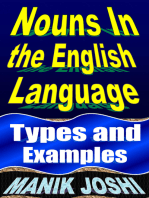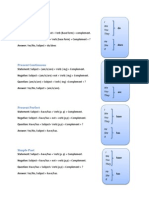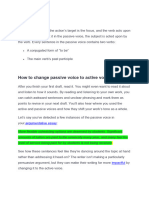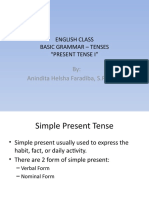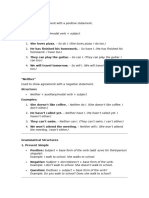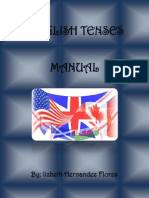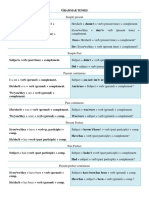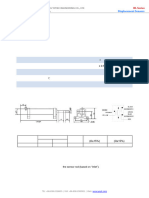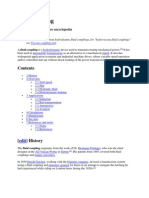Grammar Reference 1. Question Forms: A) Present Continuous (Bentuk Positif)
Grammar Reference 1. Question Forms: A) Present Continuous (Bentuk Positif)
Uploaded by
diahCopyright:
Available Formats
Grammar Reference 1. Question Forms: A) Present Continuous (Bentuk Positif)
Grammar Reference 1. Question Forms: A) Present Continuous (Bentuk Positif)
Uploaded by
diahOriginal Description:
Original Title
Copyright
Available Formats
Share this document
Did you find this document useful?
Is this content inappropriate?
Copyright:
Available Formats
Grammar Reference 1. Question Forms: A) Present Continuous (Bentuk Positif)
Grammar Reference 1. Question Forms: A) Present Continuous (Bentuk Positif)
Uploaded by
diahCopyright:
Available Formats
GRAMMAR REFERENCE
1. Question Forms
Form (as verb) Form (as preposition)
to be + subject
-
auxiliary + subject + main verb
question word + verb + object
question word + auxiliary +
subject + verb
2. Present simple and present continuous
a) Present Continuous (bentuk Positif)
The present continuous for I
subject + am + verb-ing
The present continuous for you, we and they
subject + are + -verb-ing
The present continuous for he, she, it
subject + is + verb-ing
b) Present Simple (Bentuk Negatif)
The negative present simple for I, you, we and they
subject + don’t (do not) + infinitive
The negative present simple for he, she and it.
subject + doesn’t (does not) + infinitive
c) Present Continuous (Bentuk Negatif)
The negative present continuous for I
I’m not + verb-ing
The negative present continuous for you, we and they
subject + aren’t + verb-ing
The negative present continuous for he, she, it
subject + isn’t + verb-ing.
d) Present Simple
Form - questions
do/does + subject + infinitive
e) Present Continuous
Form - questions
am/is/are+ subject + verb-ing.
3. 'Like' for preference and description
Form (as verb) Form (as preposition)
subject + like + object what + to be + noun/noun phrase + like?
4. Adverb of Frequency
a) Form – before main verb
subject + adverb + main verb
b) Form – after verb To be
subject + to be + adverb + main verb
c) Form – between a modal and main verb
subject + modal + adverb + main verb
d) Form – question
auxiliary + subject + adverb of frequency + verb.
5. ‘Have to’ and ‘must’ (obligation)
We use have to / must + infinitive without ‘to’. Must is the same form for all persons (I, you,
he, she, etc.). Have to changes to has to in the third person singular (he, she, it).
a) Positive form
Have to Subject + have/ has to + infinitive
Must Subject + must + main verb
b) Negative form
Have to Subject + auxiliary verb + have to + infinitive
Must Subject + must not + main verb
c) Question form
Have to Do/does + subject + have to + infinitive ?
Must Must + subject + infinitive ?
d) The future and the past
There is no future or past form of must. We use will have to (future)and had to (past).
Future Subject + auxiliary verb + have to + infinitive
Past Subject + had to + infinitive
e) Have got to
In informal British English, we sometimes use have got to instead of have to. They mean the
same.
6. Past Simple
We use the past simple when an action or situation happens and finishes in the past. We
usually say or know when it happened.
a) Past simple positive
Subject + verb 2 + object
b) Past simple negative
Subject + auxiliary do + infinitive without ‘to’ + object
c) Past simple questions
Question word + auxiliary do + subject + infinitive without ‘to’ + object
You might also like
- Connolly Elise Professional Learning PlanDocument31 pagesConnolly Elise Professional Learning Planapi-366807311No ratings yet
- Summary - Group 9Document7 pagesSummary - Group 9Dian Pratama AnggrainiNo ratings yet
- Simple Present (To Be) Interrogative FormDocument3 pagesSimple Present (To Be) Interrogative FormSergio Daniel Chumacero SánchezNo ratings yet
- Affirmative Negative InterrogativeDocument2 pagesAffirmative Negative InterrogativeSNINETEENNo ratings yet
- 16 Tenses Dalam Bahasa InggrisDocument6 pages16 Tenses Dalam Bahasa InggrisJonash C. Murdiny TulisNo ratings yet
- 16 Tenses Bahasa InggrisDocument7 pages16 Tenses Bahasa InggrisFajar PambudiNo ratings yet
- Formula Simple Present Tense ExampleDocument9 pagesFormula Simple Present Tense ExamplesalsaaaNo ratings yet
- Rumus Tenses Bahasa InggrisDocument1 pageRumus Tenses Bahasa Inggrisraflidinda0003No ratings yet
- Active and Passive Voice Rules ChartDocument6 pagesActive and Passive Voice Rules Chartharsh.mobineers100% (1)
- 16 Tenses in English and Part of SpeechDocument10 pages16 Tenses in English and Part of SpeechFarhan Maulana HajNo ratings yet
- Simple Present: I We You They He She ItDocument1 pageSimple Present: I We You They He She ItDeskartesNo ratings yet
- Gramática InglésDocument23 pagesGramática IngléslopezmichelleNo ratings yet
- Makalah Laporan SKP MeiDocument7 pagesMakalah Laporan SKP Meiemi pujiNo ratings yet
- English TensesDocument13 pagesEnglish TensesKevinNo ratings yet
- English HomeworkDocument3 pagesEnglish Homeworkjorge.valleppNo ratings yet
- Active Passive 1cDocument19 pagesActive Passive 1cLa Montana GBNo ratings yet
- Type of VerbsDocument6 pagesType of VerbsHùng LêNo ratings yet
- Tugas Bahasa InggrisDocument9 pagesTugas Bahasa Inggrisfajar.ramadhan4701No ratings yet
- Nesti Puji Astuti - 5117011 - Perbaikan NilaiDocument24 pagesNesti Puji Astuti - 5117011 - Perbaikan NilaiNesti PujiaNo ratings yet
- rumus tenseDocument3 pagesrumus tensePrime DicecomNo ratings yet
- Presentase Bahasa Inggris 1Document16 pagesPresentase Bahasa Inggris 1Ratna Dwi AnggrainiNo ratings yet
- Sujeto + Verbo Have, Has+ El Participio Del Verbo + Complemento. Subject + Verb Have, Has +the Participle of The Verb +complementDocument2 pagesSujeto + Verbo Have, Has+ El Participio Del Verbo + Complemento. Subject + Verb Have, Has +the Participle of The Verb +complementCarla MonterreyNo ratings yet
- Final Exam (Take Home) Subject: Basic English Grammar Lecturer: Dr. H. Fauzan, M.um, M, PDDocument10 pagesFinal Exam (Take Home) Subject: Basic English Grammar Lecturer: Dr. H. Fauzan, M.um, M, PDMuslihati AtekNo ratings yet
- By: Anindita Helsha Faradiba, S.PD., M.PD: English Class Basic Grammar - Tenses "Present Tense I"Document10 pagesBy: Anindita Helsha Faradiba, S.PD., M.PD: English Class Basic Grammar - Tenses "Present Tense I"noeksNo ratings yet
- Name: Elfrida Suryani Class:2019 A NPM:19103022 Task: Bahasa Inggris Profesi 1. Ringkasan Tenses. Jawaban: A. Simple PresentDocument2 pagesName: Elfrida Suryani Class:2019 A NPM:19103022 Task: Bahasa Inggris Profesi 1. Ringkasan Tenses. Jawaban: A. Simple PresentElfy SuryaniNo ratings yet
- Ayunita Chaerunnis2 Bahasa InggrisDocument15 pagesAyunita Chaerunnis2 Bahasa InggrisAyunita ChaerunnisaNo ratings yet
- Cours Anglais Général 01Document17 pagesCours Anglais Général 01AmoyeNo ratings yet
- MAKALAH BAHASA INGGIRS - CopyDocument19 pagesMAKALAH BAHASA INGGIRS - CopyFarhan GustamaNo ratings yet
- How to make a basic sentence in Korean -공유Document16 pagesHow to make a basic sentence in Korean -공유Judith FornalNo ratings yet
- PassiveDocument31 pagesPassiveAulia Shahnaz Pratiwi auliashahnaz.2019No ratings yet
- Passive (Autosaved)Document32 pagesPassive (Autosaved)Aulia Shahnaz Pratiwi auliashahnaz.2019No ratings yet
- SoDocument3 pagesSoisabelmeraffNo ratings yet
- English GrammarDocument61 pagesEnglish Grammarsharad95sharmaNo ratings yet
- Manual Lizbeth H FDocument18 pagesManual Lizbeth H Fapi-239674320No ratings yet
- Unit 2: Verbs 1.verb Forms A. Auxiliaries + Bare InfinitiveDocument18 pagesUnit 2: Verbs 1.verb Forms A. Auxiliaries + Bare InfinitiveLương Minh HiếuNo ratings yet
- 81479740f2716f-5b5b-44a9-aab2-2e4a9e7e974bDocument19 pages81479740f2716f-5b5b-44a9-aab2-2e4a9e7e974bSelma AoussaniNo ratings yet
- VerbsDocument4 pagesVerbsNahuel AinesederNo ratings yet
- English Verb Tenses 1: Affirmative: Negative: InterrogativeDocument11 pagesEnglish Verb Tenses 1: Affirmative: Negative: InterrogativeEvita KoenNo ratings yet
- Toefl RingkasanDocument9 pagesToefl RingkasanAndlea Yanto NovitasaryNo ratings yet
- Simple Past TenseDocument4 pagesSimple Past Tensebidan dewiNo ratings yet
- TatyDocument4 pagesTatyMuara SimorangkirNo ratings yet
- practica de inglesDocument3 pagespractica de inglessoyjosebejaranooficialNo ratings yet
- Toefl Swe Skill 1-3Document77 pagesToefl Swe Skill 1-3Tira Nur FitriaNo ratings yet
- Tabela Verb TenseDocument6 pagesTabela Verb TenseBruna Roberti SatoNo ratings yet
- Kisi kisi bahasa inggrisDocument7 pagesKisi kisi bahasa inggrisahmadfathussidikNo ratings yet
- Tiempo Oracion Afirmativa Oracion Negativa Yes/No Question Information Question Verb To BeDocument5 pagesTiempo Oracion Afirmativa Oracion Negativa Yes/No Question Information Question Verb To BeMarcelo RamosNo ratings yet
- Unit 1 Grammar Form & Function Level 3Document13 pagesUnit 1 Grammar Form & Function Level 3Diana MartinezNo ratings yet
- English - Tenses Chapter 2Document19 pagesEnglish - Tenses Chapter 2Stevie TanNo ratings yet
- Present Perfect Continuous Tense: By: Umar Al-FaroqDocument7 pagesPresent Perfect Continuous Tense: By: Umar Al-FaroqOemar Protoype RezpectorNo ratings yet
- Grammar TensesDocument2 pagesGrammar TensesAlejandro AntúnezNo ratings yet
- Tenses 2Document12 pagesTenses 2nurmaulia sukmaNo ratings yet
- Tenses notesDocument3 pagesTenses notesshankmss2009No ratings yet
- TOEFL Structure & Written Expression 1Document49 pagesTOEFL Structure & Written Expression 1nanda renta100% (1)
- I. Future Forms (Will, Be Going To, Present Continuous - Review)Document4 pagesI. Future Forms (Will, Be Going To, Present Continuous - Review)Inacio LangaNo ratings yet
- CBSE-X English_Chap-G1 (Complete Grammar)Document10 pagesCBSE-X English_Chap-G1 (Complete Grammar)shaurya singhNo ratings yet
- Past TenseDocument9 pagesPast TenseLasma Iga Ruth SaragiNo ratings yet
- TenseDocument4 pagesTensekagyviNo ratings yet
- English Assignment Thirteen Tenses: Architectural Engineering Department Faculty of Architecture and DesignDocument13 pagesEnglish Assignment Thirteen Tenses: Architectural Engineering Department Faculty of Architecture and Designnurlatifah indri25No ratings yet
- Review of TensesDocument5 pagesReview of TensesLoredana ConstantinNo ratings yet
- Statement of PurposeDocument1 pageStatement of PurposeHafsah MerajNo ratings yet
- Xiaomi RedmiNote8 Ginkgo 2022-07-10 20-53-13Document5 pagesXiaomi RedmiNote8 Ginkgo 2022-07-10 20-53-13QIUQIUNo ratings yet
- 201.26-RP1 5-08 YCWL0056 Through YCWL0610 R-410ADocument72 pages201.26-RP1 5-08 YCWL0056 Through YCWL0610 R-410AEmanuel Duarte100% (1)
- Iso PhysicsDocument4 pagesIso Physicslesly AnneNo ratings yet
- Econ of AttentionDocument32 pagesEcon of Attentionj00000000No ratings yet
- CURRENT LIMITING FUSE - Catalog CBUC23030 Cooper Fuse Link 30ADocument20 pagesCURRENT LIMITING FUSE - Catalog CBUC23030 Cooper Fuse Link 30AparyonoNo ratings yet
- Digital PLL Cicc Tutorial PerrottDocument118 pagesDigital PLL Cicc Tutorial PerrottSwethaVellankiNo ratings yet
- Boq (110912)Document144 pagesBoq (110912)Ali AlaliNo ratings yet
- Operations ManagementDocument90 pagesOperations ManagementGyan Singh PawarNo ratings yet
- PEATDocument3 pagesPEATsonaliforex1100% (2)
- New Resign Memo - Field ForceDocument1 pageNew Resign Memo - Field ForceSHOAIB ILYAS M.ILYASNo ratings yet
- Piping Study DrumsDocument31 pagesPiping Study Drumsradin202033% (3)
- 06-Assessment in Learning1Document12 pages06-Assessment in Learning1Regie MarcosNo ratings yet
- Test Design Specifications: Automated Teller Machine System (ATMS) Independent Verification and ValidationDocument15 pagesTest Design Specifications: Automated Teller Machine System (ATMS) Independent Verification and ValidationGeehthanJINo ratings yet
- Kalibrasi Ut Lembar 1Document1 pageKalibrasi Ut Lembar 1sumarwanNo ratings yet
- Interior Visualization and Postprocessing-2Document11 pagesInterior Visualization and Postprocessing-2MOHAMAD BASSEL SUMMAKIEHNo ratings yet
- FIZ102E SuggestedProblemsDocument26 pagesFIZ102E SuggestedProblemsSelin PınarNo ratings yet
- IBLS StandardsDocument1 pageIBLS StandardsRed WarrantNo ratings yet
- Mobile Crane Load Test Report FormDocument4 pagesMobile Crane Load Test Report FormRonny DoankNo ratings yet
- Dissertation RugbyDocument8 pagesDissertation RugbyPayToWritePaperCanada100% (1)
- Building Code Summary For All Commercial Projects (This Information To Be Copied and Placed On Drawings)Document10 pagesBuilding Code Summary For All Commercial Projects (This Information To Be Copied and Placed On Drawings)Joni Carino SuniNo ratings yet
- 1 English For Information Technology Elementa-61-70Document10 pages1 English For Information Technology Elementa-61-70HERRERANo ratings yet
- ■ Subject / Title: ★ 출처 - couldn't be found on the InternetDocument12 pages■ Subject / Title: ★ 출처 - couldn't be found on the InternetDkchksoonwNo ratings yet
- TANTRANSCO Cost Data 2020-2021Document27 pagesTANTRANSCO Cost Data 2020-2021Lingaraj Suresh LingaianNo ratings yet
- DatasheetDocument12 pagesDatasheetJaime FernandesNo ratings yet
- YOYIK HL-6-50-15 LVDT DatasheetDocument1 pageYOYIK HL-6-50-15 LVDT DatasheetTitoNo ratings yet
- Lesson 3-ContinuityDocument23 pagesLesson 3-ContinuityWayne Casanova100% (1)
- Complete Practice of Algebra by Gagan Pratap SirDocument39 pagesComplete Practice of Algebra by Gagan Pratap SirSuprakash KumarNo ratings yet
- Fluid CouplingDocument7 pagesFluid CouplingBalu SukumarNo ratings yet
